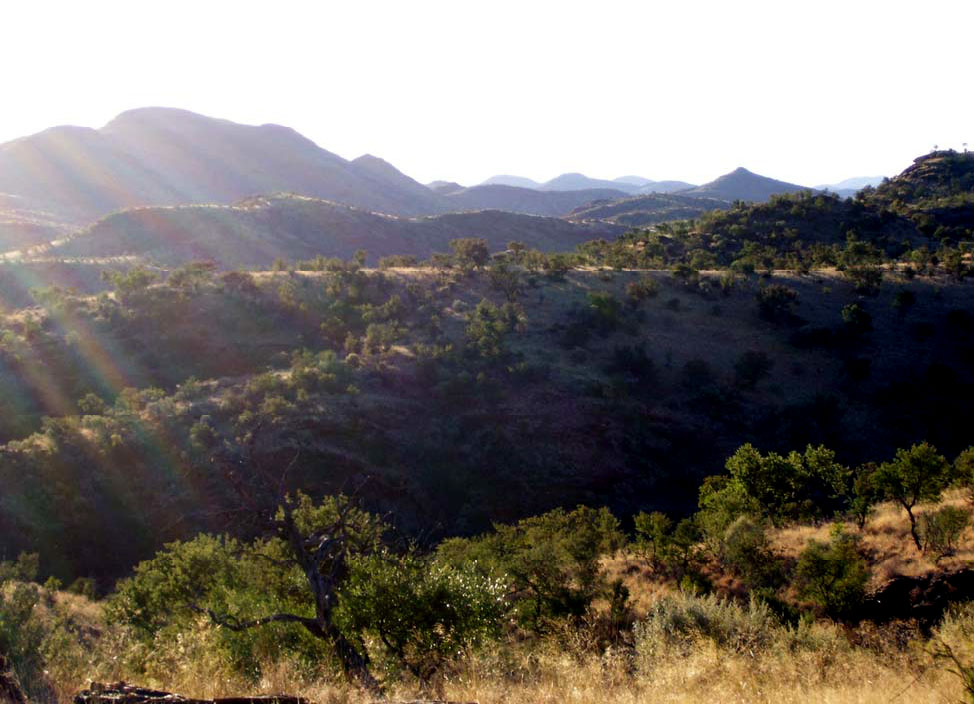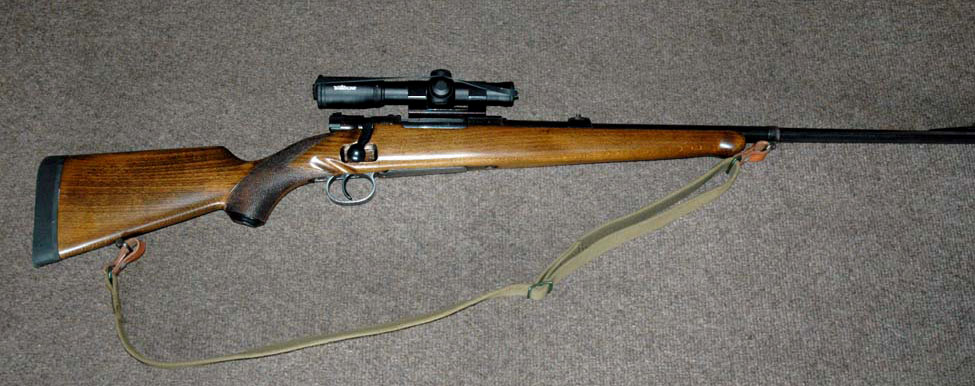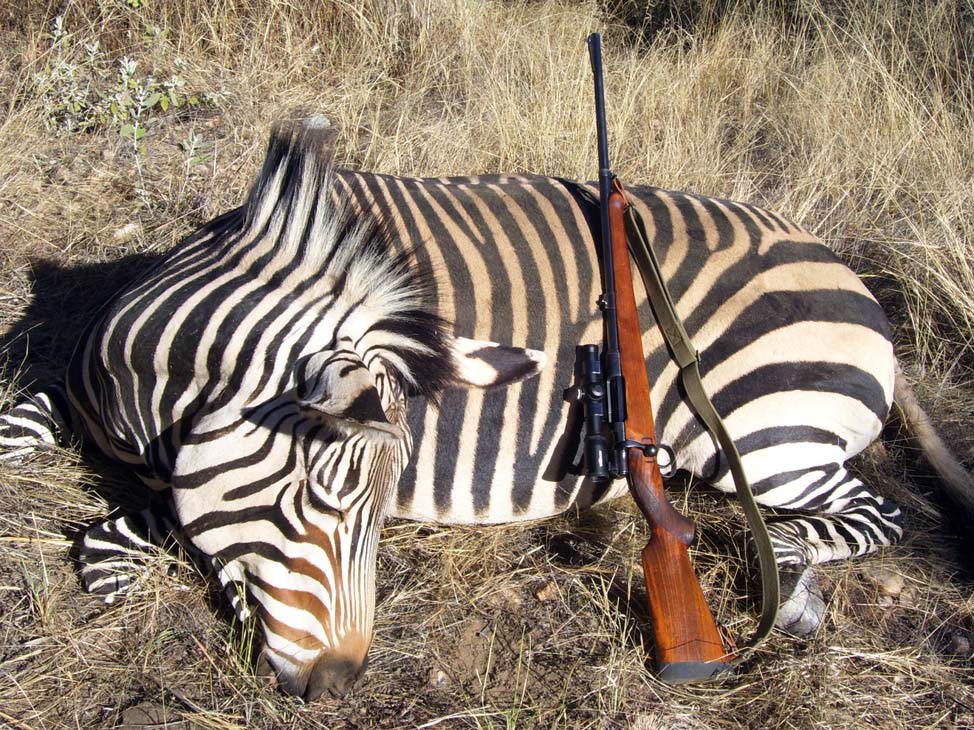

The mountains east of Windhoek, the capital city of Namibia, are part of the native range of the Hartmann’s Mountain Zebra (Equus zebrae hartmanni), a species slightly smaller than the common Burchell’s Zebra. The mountain zebra is also found in Angola and some parts of South Africa. These animals live in rocky, dry habitat and prefer slopes and plateaus as high as 3000+ feet above sea level.
They aren’t called “Mountain” zebra for nothing: the area in which we hunted them may not have been the Rockies, but they were sure-enough, real live mountains, whose steep slopes go up, down, and back up again. It’s challenging terrain in which to hunt a skittish and elusive herd animal with a reputation as one of the toughest non-dangerous game animals to kill. The hide, which lacks stripes on the belly and the “shadow stripes” of the Burchell’s, makes a spectacular trophy for display as a wall hanging or rug.
Since I was hunting in a former German colony, I used a rifle chambered for the 8x57JS Mauser, one of the first—and one of the greatest—smokeless powder rifle rounds ever developed. Originally used in the revolutionary Gewehr 1888 “Commission” rifle, the 8x57 has faded away for sporting use in the USA and in Africa, though it’s still popular in Europe. This is unfortunate, because it’s as effective and efficient a medium-bore hunting caliber as could be found, the equal of the .30-06 in the field. American ammunition companies deliberately under load it (out of fear that it may be used in weak Gew88 rifles): the best American factory load is a 170-grain bullet at 2360 FPS generating only 2102 F-P of energy. Norma loads it to its full potential: 196 grain bullets with a muzzle velocity of 2526 FPS and 2776 F-P of energy.

My rifle was a Husqvarna sporter built in 1944, making it slightly older than I am, but not by much. It's one of the very last true purpose-built sporters on the Mauser 1896 action. Husqvarna discontinued sporter production in 1944, and when they resumed sporting rifle production in 1948 they built them on purchased FN-made M98 actions.
My rifle, which Husqvarna designated the "Model 640," isn't an ex-military weapon: though it does have a stripper clip slot in the rear receiver bridge, it lacks the “thumb cut” in the left receiver rail typical of military rifles; the barrel is not stepped, and the rear sight is a single fixed open leaf. The stock is a Schnabel-tipped piece of European beechwood with modest checkering but no other ornamentation beyond a plastic grip cap.
All in all, it's a plain-vanilla working rifle, obviously intended for the domestic market—the European export market was pretty dismal in 1944! I have no idea how it came to the US, but it has no import markings and clearly has been here for many years. My only changes were addition of a recoil pad and a Burris Timberline 4x20 scope in a detachable mount. Without the pad, this lightweight gun beats me up using full-power ammunition.
As is common knowledge, pre-1898 Mauser actions aren’t as highly regarded (or as widely used) as the Model 98’s for building sporters. The reasons for this, frankly, escape me. It may have to do with the fact that most Model 96's (and the near-identical Model 94's) were built in Spain. But the Swedish Army liked the action well enough that even long after the Model 98 was the preferred action for military guns, they stuck with the Model 96.
While the M98 is certainly the most popular and successful Mauser for both sporting and military use, I’ve always felt it was a little too porky for a light hunting rifle. The M96, on the other hand, is sleek and graceful, trimmer and better balanced, and makes up into a wonderful lightweight sporter. Commercially made examples of sporting 1896’s aren’t often seen, more’s the pity.
One reason the M96 is disliked by American shooters is the cock-on-closing bolt, which they seem to have been educated to believe is a design flaw. I disagree, and I like the cock-on-closing feature. It allows a simpler, lighter, and slimmer bolt design.
Another prejudice against the Model 96 is the lack of the M98’s so-called “safety lug.” This doesn’t bother me. Any cartridge that produces enough pressure to require a safety lug is too hot for my taste! The M96 is amply strong for the calibers it was intended to use. And of course Husqvarna is one of the best gunmaking companies in the world, using the highest grade of Swedish steel.
We were hunting a huge property about 60km east of Windhoek, and the zebra were leading us a merry chase up and down the hills. Rarely did we get within 200 yards of a herd before being spotted by a pair of sharp eyes—and off they would go again. At best we were offered a couple of Hail-Mary opportunities at ranges too far for me to be comfortable with. I’m not built for rapid up-and-down movements over uneven ground. Once or twice I actually got the shooting sticks up, but the pounding of my heart and the heaving of my chest from exertion precluded any possibility of a hit. Nor am I at my best shooting from sticks when standing: I never use them hunting in North America and though I’d practiced a bit before the trip, I never really got comfortable using them.
But in the afternoon everything came together. After another couple of hours spotting and stalking, running while trying simultaneously to be quiet and yet get close enough, I was more than a little winded by the time we encountered a small group on the other side of a deep valley. They were perhaps 180 yards away. I was puffing pretty hard when my PH urged me to take a shot. I was willing but I insisted it be done from a sitting position. “Brace my back,” I asked.
This elicited a quizzical look, and I further explained, “I shoot best from a sitting position: I always have. Sit down and I’ll lean against you.” He seemed a bit puzzled by this request and by my refusal to use his sticks, but complied. I dropped to the ground, waited a few seconds to catch my breath again, braced my elbows on my knees, and put the crosshairs on the shoulder of the biggest animal in the group.

A zebra has a “triangle” of stripes on the shoulder, and this is, I had been told, the best aiming point, as the heart lies right behind it. I could see the triangle quite clearly, and miraculously I was pretty steady and confident. The shot rang out: the zebra stood stock still momentarily, then began to trot slowly away. Before I had time to work the bolt for a second shot, it dropped. The little Husky had shot straight and true: when we crossed the valley to the site of the kill, the zebra was stone dead, the bullet having gone exactly where I wanted it to, dead smack in the middle of the triangle. The Norma “Oryx” bullet—a toughly constructed one, intended for use on heavy-boned African game, as its name implies—had punched through the bone to shred the heart.
The Husky has proven to be one of those “lucky” rifles. Bought on a whim and selected for a possibly frivolous reason, it proved to have been a fine choice for a plains game hunt. Prior to the trip I took a massive whitetail buck and a feral hog with it: in Namibia it made one-shot kills on several other trophies, including a springbok, two warthogs, a beautiful impala, and a huge eland. I know nothing of its history before it came into my hands: but I believe that in its 66 years it probably served its previous owners as well as it has served me.
| HUNTING | GUNS | DOGS |
| FISHING & BOATING | TRIP REPORTS | MISCELLANEOUS ESSAYS |
| CONTRIBUTIONS FROM OTHER WRITERS|
| RECIPES |POLITICS |